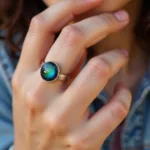Aluminum, in its raw and untreated form, doesn’t have a single, definitive color. It’s naturally a silvery-gray metal. However, the way we perceive its color can be influenced by several factors such as surface finish, lighting conditions, and the presence of coatings or treatments.
Understanding Aluminum’s Appearance
While we commonly associate aluminum with its shiny, metallic appearance, this isn’t its natural state. When exposed to air, aluminum rapidly forms a thin, transparent oxide layer on its surface. This layer, though invisible to the naked eye, plays a crucial role in defining how we see the metal.
This oxide layer is responsible for aluminum’s corrosion resistance and also contributes to its reflective properties. Depending on the angle of light and the smoothness of the surface, this reflection can range from a dull gray to a bright, mirror-like finish.
Factors Affecting Aluminum Color Perception
Several factors can alter how we perceive the color of aluminum:
- Surface Finish: The texture of the aluminum surface significantly impacts its appearance. A polished or brushed finish will appear brighter and more reflective compared to a matte or anodized surface.
- Lighting Conditions: The type and intensity of light can influence how our eyes perceive the color of aluminum. Natural daylight tends to reveal its true silvery-gray color, while artificial light might cast a slightly warmer or cooler hue.
- Coatings and Treatments: Aluminum is often anodized or painted for both aesthetic and functional purposes. Anodizing, an electrochemical process, can create a range of colors on the aluminum surface, from subtle bronzes to vibrant blues and reds. Similarly, powder coating offers a virtually unlimited color palette.
Common Applications and Their Associated Colors
Aluminum’s versatility makes it a popular choice across numerous industries. Here are a few examples:
- Construction: Used in windows, doors, and roofing, aluminum in construction typically has a clear anodized finish or is painted white for its reflective properties, helping to regulate indoor temperature.
- Automotive: In the automotive industry, aluminum is favored for its lightweight properties. It’s often seen in its natural silvery-gray finish or painted to match the vehicle’s color scheme.
- Packaging: Aluminum foil, widely used in food packaging, has a distinctive shiny silver appearance due to its highly reflective surface.
- Electronics: Found in smartphones, laptops, and tablets, the aluminum used often has a sleek, anodized finish in shades of gray, silver, or black.
Aluminum and Color: A Versatile Combination
Understanding the nuances of aluminum’s color, or rather the factors influencing its perceived color, opens up a world of possibilities. From its natural silvery-gray to a spectrum of colors achievable through various treatments, aluminum provides designers and manufacturers with both aesthetic flexibility and high performance. Whether you’re looking for a sleek, modern look or a vibrant, eye-catching finish, aluminum offers a solution.
